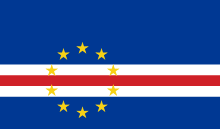Music of Cape Verde
| Part of a series on the |
| Culture of Cape Verde |
|---|
 |
| History |
| People |
| Languages |
| Religion |
|
Music and performing arts |
|
Media |
| Sport |
|
Monuments |
|
Cape Verde is known internationally for morna, a form of folk music usually sung in the Cape Verdean Creole, accompanied by clarinet, violin, guitar and cavaquinho. Funaná, Coladeira, Batuque and Cabo love are other musical forms.
History
Cape Verde is an island archipelago that was uninhabited until the Portuguese arrived in 1462. The sailors brought with them African slaves, and the islands' population became mixed with elements of both races. Climate conditions made the islands inhospitable, and the Portuguese governments mostly ignored the inhabitants and the frequent droughts and famines that wracked the islands periodically. As a result, there are now more Cape Verdeans abroad than at home, and sizable communities exist in New England, Portugal, Wales, Senegal, Italy, France and the Netherlands.
In 2011, it would be one of the most recent countries to have its own music award, the Cabo Verde Music Awards was established and awards the greatest songs of the year by Cape Vedean artists (and those of abroad).
Folk music
Morna
Morna is by far the most popular genre of Cape Verdean music, and it has produced an international superstar in Cesária Évora. Morna is a national song-style, like Argentinian tango, beloved by Cape Verdeans across the many islands of the country. Lyrics are usually in Creole, and reflect highly-variable themes, including love and lust, patriotism and mourning.
Morna is believed to have originated on Boa Vista as a cheerful song-type. Eugénio Tavares was an influential songwriter of the period, and his songs are still extensively performed. Morna also spread to São Vicente, and composers like B. Leza and Manuel de Novas became popular. Solo vocalists are accompanied by a guitar, violin, bass guitar) and a piano. The cavaquinho (similar to a ukulele), a Portuguese instrument, is also common.
In the 1930s, Morna evolved in a swifter form of music called coladeira. It is a more light-hearted and humorous genre, with sensual rhythms. Performers include Codé di Dona, Manuel de Novas, Frank Cavaquim, Djosa Marques and Os Tubarões.
Aside from Évora, popular morna musicians include Ildo Lobo, Titina, Celina Pereira, Bana, Djosinha, B. Leza, Travadinha, Sãozinha and Maria Alice.
Funaná
Funaná is an accordion-based genre from Santiago. Prior to independence, funaná was denigrated by colonial authorities, who considered it African. Since independence, however, bands like Bulimundo adapted the music for pop audiences and Finaçon, who combined funaná and coladeira into a fusion called funacola.
Batuque
Batuque is also popular in Cape Verde. Originally a woman's folk music, batuque is an improvised music with strong satirical or critical lyrics. In the 80's, Orlando Pantera has created the "new batuco" (neo-batuku), but he died in 2001 before to achieve his creative work. Performers and songwriters are Pantera, Vadú, Tcheka, Mayra Andrade, Lura, Zeca di nha Reinalda.
Coladeira
Coladeira is a form of dance and music from Cape Verde.
Popular music
Cola-zouk
The musical style Coladeira originating from the Cape Verde islands is a derivative of Compas, promoted by French Antilles artists as zouk mixed with the coladeira and other Cape verdian rhythms. There has been a fusion of the zouk love with the coladeira, to which several names have been given, such as cola-dance, cola-zouk, cabo-swing, Cabo love, etc. In this variant, the rhythm has the same accentuation as the compas, the instrumentation is also copied from the zouk, the accentuation of the melody line is different, the syncopation is made in other contexts and the melody line is less continuous than the traditional coladeira, with breaks.
There are many Cape Verdeans living abroad, especially in the United States, where they are concentrated in California, Hawaii and throughout New England, especially Rhode Island and Boston. Many came on whaling ships in the 19th century. Their music included string bands like The B-29s, Notias, Augusto Abrio and the Cape Verdean Serenaders. There were also Cape Verdean big bands, including the Creole Vagabonds and the Don Verdi Orchestra.
See also
References
- Máximo, Susana and David Peterson. "Music of Sweet Sorrow". 2000. In Broughton, Simon and Ellingham, Mark with McConnachie, James and Duane, Orla (Ed.), World Music, Vol. 1: Africa, Europe and the Middle East, pp 448–457. Rough Guides Ltd, Penguin Books. ISBN 1-85828-636-0
- Musical documentary Cape Verde: KONTINUASOM
- Radio Kriola traditional and modern cape verdean music, African and creole music
- Audio clip (60 minutes): Morna, Batuque and Eugenio Tavares. BBC Radio 3. Accessed November 26, 2010.
- Audio clip (60 minutes): Cesaria Evora, Bau and Tito Paris. BBC Radio 3. Accessed November 26, 2010.